Saving Big Forests to Save The Planet
Air Date: Week of October 21, 2022
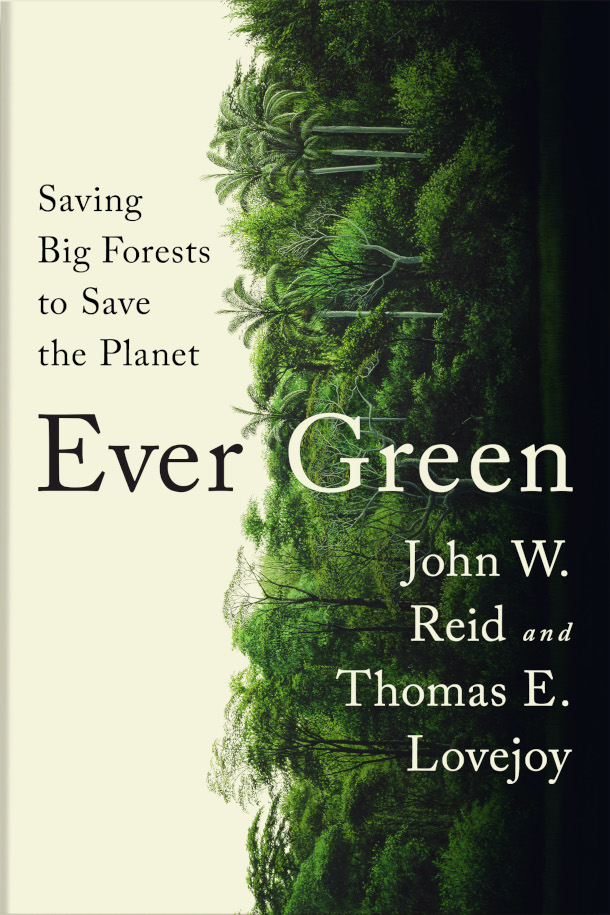
John Reid and Thomas Lovejoy’s 2022 book “Ever Green: Saving Big Forests to Save the Planet” (Photo: Courtesy of W. W. Norton)
Protecting the remaining intact big forests on Earth offers a low-cost and highly beneficial way to mitigate the climate crisis. The new book “Ever Green: Saving Big Forests to Save the Planet”, coauthored by economist John Reid and the late ecologist Tom Lovejoy, puts a spotlight on these so called “mega forests”. John Reid joined Host Steve Curwood to describe these majestic places, the threats they face, and why they are worth protecting.
Transcript
CURWOOD: Some proposals for mitigating the climate crisis require huge societal changes or unproven technological innovations. But protecting the remaining intact big forests on Earth is by comparison a bargain. The new book “Ever Green: Saving Big Forests to Save the Planet”, coauthored by economist John Reid and the late ecologist Tom Lovejoy, puts a spotlight on these so called “megaforests”. Thomas Eugene Lovejoy III passed away in December 2021 and we remembered his huge contributions to conservation on this show earlier this year. And although he’s gone from this world, Tom continues to teach us how to take care of it. I spoke with his coauthor John Reid about these forests and the opportunity they present in mitigating climate change.
John, welcome to Living on Earth.
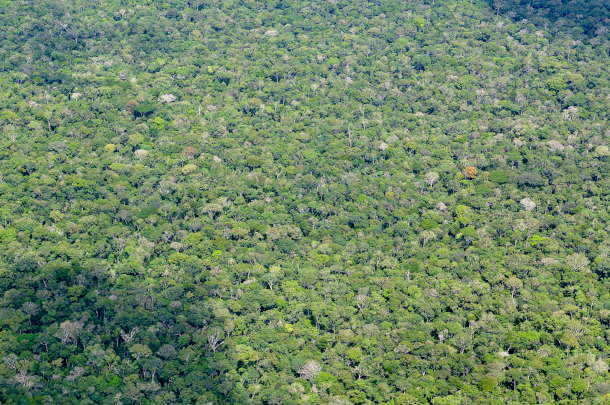
Thomas Lovejoy’s work in the Amazon rainforest showed that large intact forests sequester more carbon more stably and with more resilience than fragmented forests (Photo: Neil Palmer/CIAT, Flickr, CC BY-NC-ND 2.0)
REID: Thank you so much, Steve. It's an honor to be here.
CURWOOD: Your book is all about megaforests. What exactly is a megaforest? And how many of them are there? And where do we find them on the planet?
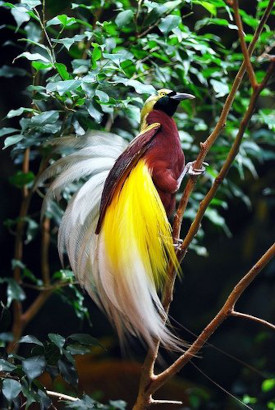
The island of New Guinea is home to 39 of the world’s 42 species of birds of paradise (Photo: Richarderari, Wikimedia Commons, CC BY-SA 3.0)
REID: So, the term “megaforest”, we use to describe five forests that are still with us here on planet Earth. And the characteristics of these forests, first of all, that they're big, they're continental in scale, and that a good part of those forests is still intact in pieces of at least 500 square kilometers. There are three tropical forests: the Amazon, the Congo, and the island of New Guinea, and then two boreal forests: the forest that covers a good part of the state of Alaska, and then goes all the way across northern Canada, just below the the tundra zone, and the Russian Taiga, which is a forest that spreads from the Bering and Pacific sea coast of Russia, all the way across the continent to Scandinavia. And this used to be just one boreal forest at certain times when the sea level was low enough to expose the Bering Land Bridge, so you see remarkable similarities between the organisms that are on both sides of the Pacific in these boreal forests.
CURWOOD: What, between the caribou and the reindeer?
REID: Yeah, and you see grizzly bears and what they just call brown bears in Russia. There were bison roaming on both sides, and of course, the human beings used that geography to move back and forth between the Americas and the Eurasian continent.
CURWOOD: John, what makes these megaforests different from each other?
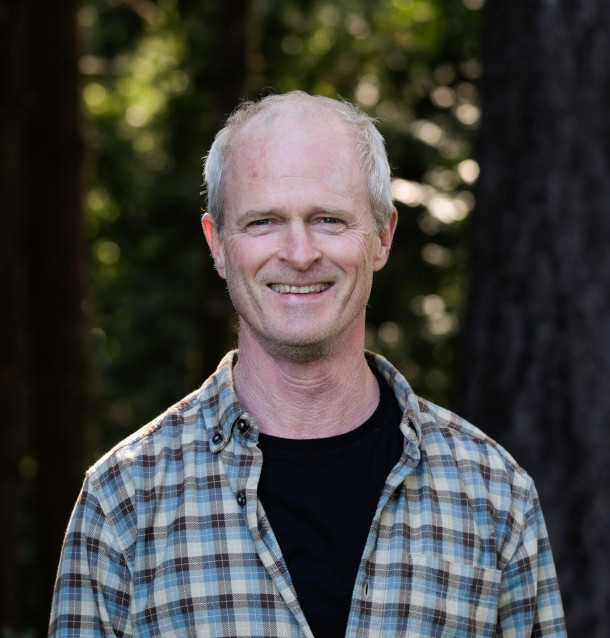
John Reid is the co-author of “Ever Green: Saving Big Forests to Save the Planet”. (Photo: Courtesy of W. W. Norton)
REID: First of all, we have a difference between the boreal forests and the tropical forests. And this is what you would expect, the boreal forests are cold and the tropical forests are hot and steamy. The tropical forests have an incredible diversity of plants and animals, and the boreal forests have less diversity, but they have, in general, larger organisms like grizzly bears and polar bears, caribou.
CURWOOD: The tropical forests, what differences do you see there?
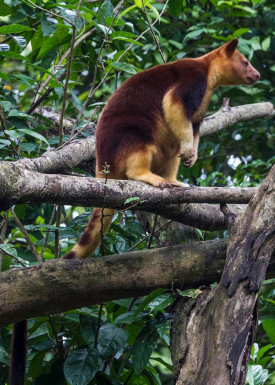
New Guinea is on the same tectonic plate as Australia and has many related species, such as the tree kangaroo (Photo: Shebalso, Wikimedia Commons, CC BY-SA 2.0)
REID: Well, the tropical forests are very different from one another. The Amazon, if you walk around in the Amazon, you'll see a profusion of palm trees and of vines. If you cross the Atlantic to the Congo, you have massive animals. So you have forest elephants and you have three different species of gorillas, you have chimpanzees, you have bonobos, you have large ungulates. Now go over to New Guinea, you have a whole different array of species there. New Guinea is the world's capital for birds of paradise. There are 39 of the globe's 42 species of birds of paradise. You have species that look like they belong in Australia. One night, I was walking through the forest with a local guy and we came upon a kangaroo. And in the middle of a tropical forest in the New Guinea night, this thing looked, to me, so out of place, but it's because New Guinea is on the same tectonic plate as Australia and has been separated from the Australian mainland for a short enough period of time that many of the families of plants and animals that you find in New Guinea have Australian counterparts, even though the species have had a long enough time to diverge and create novel life forms there.
CURWOOD: Now, John, why is it so important to protect these few huge expanses of undisturbed forest instead of lots of smaller forested areas?
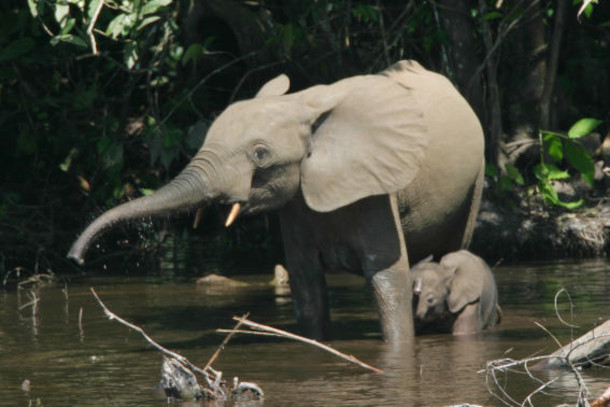
Unlike the Amazon, the Congo is home to massive animals such as elephants, which are vulnerable to the bushmeat trade and illegal poaching for ivory (Photo: Thomas Breuer, Wikimedia Commons, CC BY 4.0)
REID: Well, there are, I think, three things that I would point to. First of all, those places that haven't been carved up by roads, or carved up by industrial development, and settlements, or industrial agriculture, have ecological functions that are absent in forests that have been fragmented, and not just ecological functions, but climate functions. These are places that are storing more carbon, more stably, with more resilience than the fragmented forests in our world. And Tom's early research in the Amazon really demonstrated very graphically why this happens. His project created forest fragments in the Amazon in an area that was being actively deforested, and he made agreements with ranchers to leave plots of land with forest. And so what his scientific team observed over time is that those forest edges dried out, the wind knocked trees down, and there were species that were important to regenerating trees that couldn't survive in that environment anymore. The second thing I wanted to mention really has more to do with people. And our earth is still blessed with incredible forest-based cultures with human beings who grew up in the forest, whose languages emerged from the forest, whose livelihoods are tied to the forest, whose spirituality is linked to the forest. And those cultures need large forest areas in order to thrive, not just to have access to the resources that they need to thrive, but also to have some insulation from the homogenizing power of our surrounding society. The third reason that we really focus on this has to do with irreversibility. Once an ecosystem is fragmented by a road, for example, that intactness is hard to get back, and the species that are dependent on the intactness and the cultures and languages that are dependent on the intactness are impossible to get back. So that's where some of the urgency of protecting these places in particular comes from.
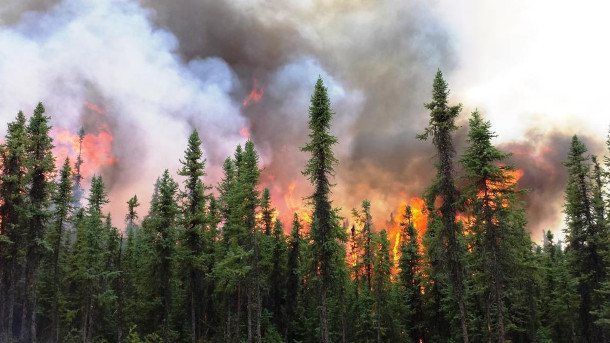
The Russian Taiga is experiencing a large increase in wildfires that has been linked to the development of roads (Photo: US Department of Agriculture, Flickr, CC BY 2.0)
CURWOOD: Writing about deforestation and forest degradation, you talk a lot about roads. Why does building roads in intact forests have such a large and wide-ranging spectrum of damage and why, as you talk about in the book, does this not make much economic sense?
REID: Well, I've been studying roads in tropical forests since the mid 90s and, almost without exception, found that remote roads in intact forests don't pencil out financially in terms of the transportation benefits justifying the expense of putting the asphalt down and taking care of it. And that's just because there isn't enough economic activity there and users to justify having a fancy road. You do have people using it. First of all, the first to come are loggers. And then you'll have small farmers, subsistence farmers, who come and clear plots of land beside the road. And then after them will often come a larger farmer or land speculator who will buy up small farms, clear the area for cattle pasture. So in South America, in particular, this has been a progression that we've just seen over and over and over again. And to build a road in a tropical forest today and expect something different just doesn't really make much sense. Now, in the other forests around the world, even the tropical forests, you haven't seen the same dynamic of dramatic deforestation following roads. What you have seen, for example, in the Congo, is dramatic increases in hunting pressure. So you have species such as forest elephants, the poaching goes up dramatically, the poaching of primate species, of just the range of species that are targeted for bushmeat. The boreal forest, the roads are often associated, particularly in the Russian Taiga, with new sources of fire ignition. Fire is a huge problem across the Taiga. Over in Canada, you have species like caribou that are extremely sensitive to the presence of roads, often won't cross roads, and when roads are put in, the areas that they have as their refuges when the mothers, for example, are nursing their calves, become too small for them to be viable areas. And it's not only the humans who are going out there hunting them, but wolves use roads as hunting trails as well and put so much pressure on the caribou that wildlife managers in Canada then have to decide whether or not to go out and shoot the wolves. And sometimes they do.
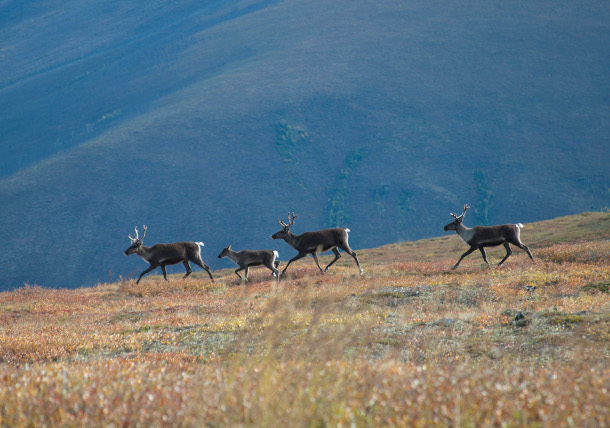
Some species, such as caribou are especially sensitive to the development of roads (Photo: Craig McCaa, Bureau of Land Management, Wikimedia Commons, CC BY 2.0)
CURWOOD: So much of the commercial global north is interested in making money over the short term: gold, oil, gas. How do we start using economics to convince decision makers in these northern and rich countries to protect the intact natural landscapes that you say are really worth saving?
REID: Well, I think a good start, Steve, would be a more responsible news media. When you read the business news, you'll see reporting about the housing sector, the energy sector, the transportation sector, without any comment whatsoever on the climate implications of growth or retrenchment in those sectors, and we have to begin to recognize that everything we do has climate impacts, and the kind of economy that we want, the kind of growth that we want, the kind of energy prices we want, have everything to do with the climate we're going to get. And the truth of the matter is that we have to do everything to get to the kind of climate that we can live with that will permit a vibrant beautiful, interesting, livable world. So do we need to save our megaforests? Yes. Do we need to replant forests? We have to do that also. And do we have to address our fossil fuel problem? We have to do that too. But to protect the intact forests around the world doesn't require any technological innovations, and so a lot of the economists who have looked at this make the point that over the long term, we need to make all kinds of transformations in the way we live, in the short term, stopping deforestation is something we can do right away.
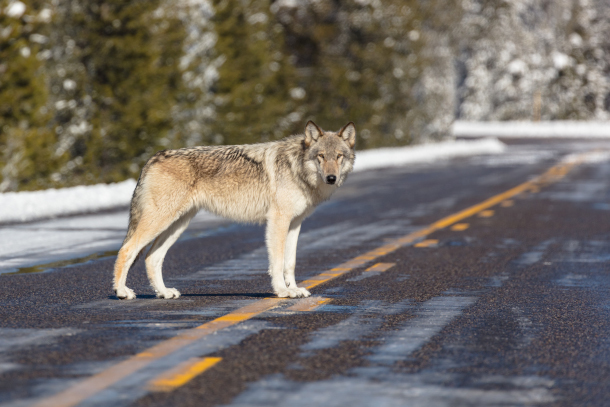
Wolves use roads as hunting trails, putting pressure on prey species, leaving wildlife managers with difficult decisions (Photo: Jacob W. Frank, National Park Service, Flickr, public domain)
CURWOOD: This book, I think, is required reading for anybody who is really looking for practical, affordable solutions to take on the climate crisis. And the book is called "Ever Green: Saving Big Forests to Save the Planet", written by John Reid, our guest, and by the late Thomas Lovejoy. John Reid, thanks so much for taking the time with us today.
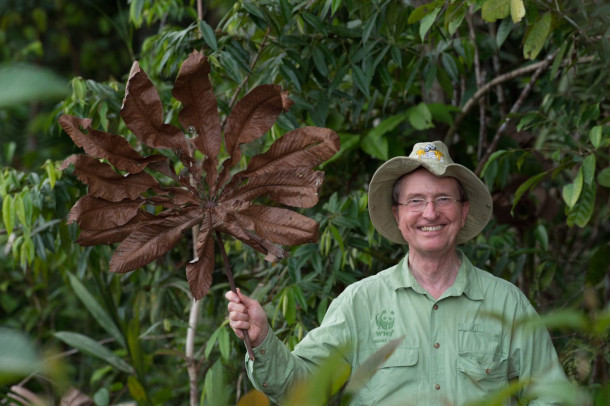
The late Thomas Lovejoy co-authored “Ever Green: Saving Big Forests to Save the Planet”. (Photo: Courtesy of W. W. Norton)
REID: It's been my pleasure, Steve, thank you so much.
Links
[Find the book “Ever Green” here (Affiliate link helps donate to LOE and local indie bookstores]
Listen to LOE’s 2010 interview with Thomas Lovejoy on saving the world’s biodiversity
Living on Earth wants to hear from you!
Living on Earth
62 Calef Highway, Suite 212
Lee, NH 03861
Telephone: 617-287-4121
E-mail: comments@loe.org
Newsletter [Click here]
Donate to Living on Earth!
Living on Earth is an independent media program and relies entirely on contributions from listeners and institutions supporting public service. Please donate now to preserve an independent environmental voice.
NewsletterLiving on Earth offers a weekly delivery of the show's rundown to your mailbox. Sign up for our newsletter today!
 Sailors For The Sea: Be the change you want to sea.
Sailors For The Sea: Be the change you want to sea.
 The Grantham Foundation for the Protection of the Environment: Committed to protecting and improving the health of the global environment.
The Grantham Foundation for the Protection of the Environment: Committed to protecting and improving the health of the global environment.
 Contribute to Living on Earth and receive, as our gift to you, an archival print of one of Mark Seth Lender's extraordinary wildlife photographs. Follow the link to see Mark's current collection of photographs.
Contribute to Living on Earth and receive, as our gift to you, an archival print of one of Mark Seth Lender's extraordinary wildlife photographs. Follow the link to see Mark's current collection of photographs.
 Buy a signed copy of Mark Seth Lender's book Smeagull the Seagull & support Living on Earth
Buy a signed copy of Mark Seth Lender's book Smeagull the Seagull & support Living on Earth

